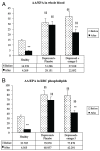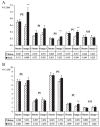Comparison between the AA/EPA ratio in depressed and non depressed elderly females: omega-3 fatty acid supplementation correlates with improved symptoms but does not change immunological parameters
- PMID: 23046564
- PMCID: PMC3499393
- DOI: 10.1186/1475-2891-11-82
Comparison between the AA/EPA ratio in depressed and non depressed elderly females: omega-3 fatty acid supplementation correlates with improved symptoms but does not change immunological parameters
Abstract
Background: Depression is one of the most frequently missed diagnoses in elderly people, with obvious negative effects on quality of life. Various studies have shown that long chain omega-3 polyunsaturated fatty acids (n-3 PUFA) may be useful in its management. Our objective was to evaluate whether a supplement containing n-3 PUFA improves depressive symptoms in depressed elderly patients, and whether the blood fatty acid pattern is correlated with these changes.
Methods: The severity of depressive symptoms according to the Geriatric Depression Scale (GDS), blood fatty acid composition and erythrocyte phospholipids were analyzed in 46 depressed females aged 66-95y, diagnosed with depression according to DSMIV, within the context of a randomized, double-blind, placebo-controlled trial. 22 depressed females were included in the intervention group (2.5 g/day of n-3 PUFA for 8 weeks), and 24 in the placebo group. We also measured immunological parameters (CD2, CD3, CD4, CD8, CD16, CD19 and cytokines (IL-5, IL-15).
Results: The mean GDS score and AA/EPA ratio, in whole blood and RBC membrane phospholipids, were significantly lower after 2 months supplementation with n-3 PUFA. A significant correlation between the amelioration of GDS and the AA/EPA ratio with some immunological parameters, such as CD2, CD19, CD4, CD16 and the ratio CD4/CD8, was also found. Nevertheless, omega-3 supplementation did not significantly improve the studied immunological functions.
Conclusions: n-3 PUFA supplementation ameliorates symptoms in elderly depression. The n-3 PUFA status may be monitored by means of the determination of whole blood AA/EPA ratio.
Figures





References
-
- Simopoulos AP. Genetic variants in the metabolism of omega-6 and omega-3 fatty acids: their role in the determination of nutritional requirements and chronic disease risk. Exp Biol Med. 2010;235(Suppl 7):785–95. - PubMed
-
- Gopinath B, Harris DC, Flood VM, Burlutsky G, Mitchell P. Consumption of long-chain n-3 PUFA, α-linolenic acid and fish is associated with the prevalence of chronic kidney disease. Br J Nutr. 2011;105(Suppl 9):1361–8. - PubMed
-
- Peet M. Eicosapentaenoic acid in the treatment of schizophrenia and depression: Rationale and preliminary double-blind clinical trial results. Prostaglandins Leukot Essent Fatty Acids. 2003;69(Suppl 6):477–85. - PubMed
-
- Politi P, Rocchetti M, Emanuele E, Rondanelli M, Barale F. Randomized Placebo-Controlled Trials of Omega-3 Polyunsaturated Fatty Acids in Psychiatric Disorders: a Review of Current Literature. Curr Drug Discov. 2011. in press. - PubMed
-
- Milte CM, Sinn N, Howe PR. Polyunsaturated fatty acid status in attention deficit hyperactivity disorder, depression, and Alzheimer's disease: towards an omega-3 index for mental health? Nutr Rev. 2009;67(Suppl 10):573–90. - PubMed
Publication types
MeSH terms
Substances
LinkOut - more resources
Full Text Sources
Medical
Research Materials

